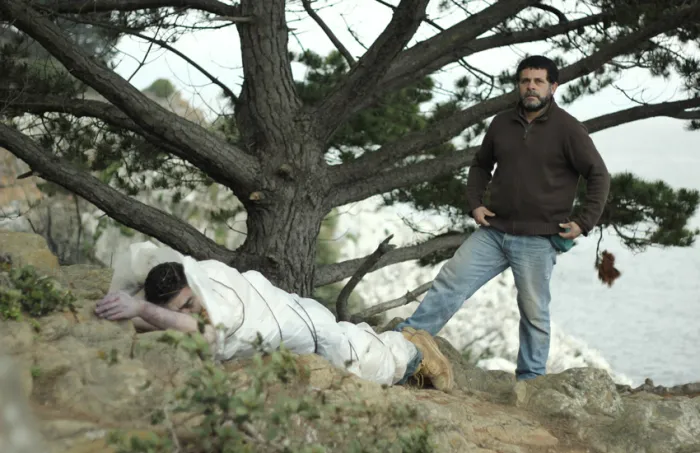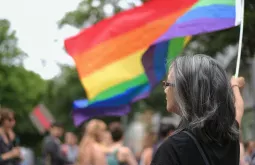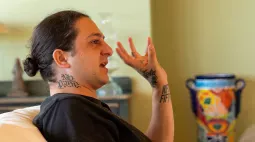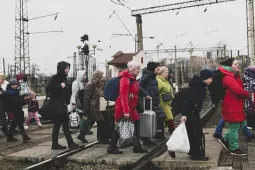Colombian cinema

In the main headquarters of the International Film Festival in Cartagena the first and only kiosk that greeted visitors, extended an unexpected invitation. Pick up a form and note down your ideas and suggestions about the conversations between the rebel group of the Revolutionary Armed Forces of Colombia (FARC) and Colombian government officials, which began in Cuba in September 2012. When you finished you could mail it in for free, and of course you could also take the government information pamphlet about the ongoing peace process. This May the government of Juan Manuel Santos, which stands behind the political initiative, is up for reelection. Colombian politics are up in the air, one could say, and festival-goers would not be totally spared.
Beyond the kiosk in the festival celebrated last week, there is a long-standing tradition in Colombian cinema of dealing with politics dating back to the 1920s, according to the critic and professor Margarita de la Vega Hurtado. “In Latin American cinema, politics is a mainstay that sometimes takes a poetic disguise. When US movies deal with politics, the discourse needs to be blunt. If it’s not clearly spelled out, they think it’s not there”, she says. In Colombia, the surge of the guerrilla in the 1960s generated documentaries that tried to analyze and inform the public about the conflict, through underground screenings. That sense of urgency later gave way to more reflective and allegorical works. And as the conflict took a bitter turn and violence reached a fever-pitch, the cinematic discourse broadened. Now, the new political context in Colombia and the peace talks that aim at resolving 50 years of violence seem to be finding their way into contemporary Colombian movies such as “Mateo”, or the animated feature “Desterrado”, both of them showcased at the International Film Festival of Cartagena. This week the Colombian Film Festival in New York will show 14 features, 20 short films, and four documentaries.
So, how is cinema approaching the hopeful moment that the country is experiencing? Maria Gamboa’s first feature, “Mateo”, takes an indirect approach to address how to forgive and put an end to a conflict. The young protagonist of this movie collects extortion money for the local mob boss, and agrees to infiltrate and report on a theatre group. In one scene, Javier, the young and dynamic Colombian priest who directs the workshop, informs the teenagers that he will sit down and talk with the self-confessed snitch. The young actors wonder out loud if they’ll be able to forgive the informer, whose actions forced one of the members of the group to leave their city. Internal displacement will comes as no surprise to the Colombian audience of this movie. It is estimated that nearly people five million people have been forced to relocate as a result of the violent clashes in the past decades between the guerrilla, the army and the paramilitary. They are “the displaced”.
“Mateo” was shot with non-actors in a “comuna” of Barrancabermeja, a city with oil plants, a stronghold of unions and left-wing parties, where a massacre by the paramilitary took place in 1998. So Gamboa’s work is immersed in the so-called conflict both thematically and geographically. Still, the words guerrilla, FARC, paramilitary, or cocaine are never uttered in this feature. This telling silence may offer a hint at the vast dimension of the collective trauma surrounding the conflict. “I did not feel the need to spell it out, after all the conflict has to do with poverty and the lack of opportunities. I wanted to speak about dignity, and how art can make a difference and prevent youngsters from falling into the spiral of violence. My interest lies in the people who have been caught in between”, Gamboa explains.
Another way to look at the peculiar lexicon that characterizes the violence in Colombia is expressed by an old university professor in the animated feature “Desterrada”. One of the characters, Camilo, warns his students that it is important to be careful with the terms used to talk about the conflict. The guerrilla started in the 60s, when left-wing parties were illegal, and have since been legalized, but, was it worth it even back then? He laments that frustrated reconciliation processes have turned into a recurrent theme in the past decades; only the number of the displaced and the inequality index have soared. In “Desterrada” Camilo’s lesson gives way to a nightmarish distortion, manga style, of Colombia’s historic tragedies. The film breaks loose from facts. It describes a youthful love story set in a dystopian scene, of constant raids in Bogotá, curfew and forced conscription, against a backdrop of storming rock guitars. The only possible way to survive is to leave the country. “The film is a kind of metaphor, an exaggerated nightmare based on what we’ve lived through, something you wish that will never be true”, explains the director, Diego Guerra. The distortion of Colombia’s recent history in his film debut was labeled as hyper-magical-realism by a member of the audience in the free access festival of Cartagena. Guerra liked it.
But perhaps the most powerful interaction with the audience happened on Friday night in the loud and lively mall on the impoverished ourskirts of the Caribbean city, during the first screening in Colombia of Gamboa’s “Mateo”. The film seemed to act as a sort of potent collective therapy. When the lights went back on, the organizers asked the public to stay put: the director wanted to talk to them and hear their reactions to her work. A middle-aged man took the microphone, barely holding back his tears, as he congratulated the director. Teenagers like the ones featured in “Mateo” also seized on the opportunity to speak out loud about the role of art as means to unlock traumas, and come to terms with a violent past. The director embraces the social role that her movie can play in the political scenario, with elections in two months. She is working on a plan to show her movie in small villages across Colombia. “I wanted to avoid political propaganda, but I understand that the movie perfectly fits the current political and social discussion in Colombia”.
Colombia’s movie industry has grown exponentially, and is now Latin America´s fourth largest, with over 20 productions last year. The new cinematic voices of Gamboa and Guerra approach the past and present of the conflict, in a distinct way. “Desterrada” and “Mateo” strike a timely chord and pose some powerful and urgent questions. What does it take to forgive and make peace? Can art help?






